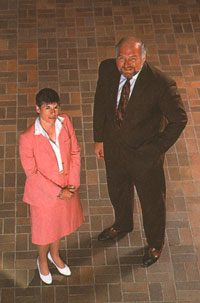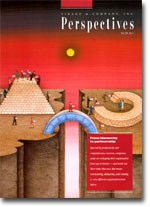
AT&T Capital: Life On The Leading Edge
Perspectives - Volume III, Number 1 - Sibson & Company
Long before "delayering," "restructuring the organization," and "organizational ownership" were in vogue, AT&T Capital Corporation applied the principles of participative and innovative management and received recognition from, among others, Business Week. By position itself on the leading edge of the hierarchy/partnership debate, the AT&T subsidiary hoped to maximize its internal resources and establish itself as one of the leaders in the telecommunications leasing industry.
AT&T Capital's Ruth Morey and Tom Wajnert "We've always believed in being nimble and flexible - an organization able to react to a changing set of customer requirements," says Thomas C. Wajnert, AT&T Capital's president since its inception in1985. "So, in the beginning we worked together as a very small entrepreneurial organization where everyone knew one another and everyone worked together in a team fashion without a lot of hierarchy."
But as the organization grew and competition in the leasing industry intensified, AT&T Capital became more complex and found itself succumbing to having "checkers to check the checkers." The company went from being a functional organization to a matrix organization to a multidivisional organization.
Problems began to surface. "Not only were we having difficulty reconciling our reward system to our parent, AT&T, "Wajnert says, "but we found that our people were not very happy with the structure of the organization. They wanted to grow and wanted more accountability. But it was difficult to offer them any of these things with the kind of organization we had at that time."
The answer, for AT&T Capital, was a new kind of organization: Very different from the more formal and highly structured AT&T environment. Devoid of unnecessary hierarchy. Oriented toward the customer. Committed to empowering its people to make decisions on their own and providing them with the resources and information to do so.
So AT&T Capital began to change. First to go were the symbols of hierarchy and rank. "Employees" became "organization members." Internal titles disappeared and were replaced by functional descriptions of members. A team orientation was emphasized. Even office floor plans were altered with customer service and improved productivity - and not rank or status - determining the new design.
More systemic changes were also required. Wajnert and his senior management team set out to structure an organization that reflected their operating principles. The pressure was on, since the industry was growing and AT&T Capital, despite its growing pains, was expanding quickly.
But Wajnert's goal was never to flatten the organization. "I'm not espoused flatter organizations," he says. "I'm saying that to get the job done, we need to give more accountability to people who are closer to the customer or to the decision that needs to be made.
"I can't talk about hierarchy and also talk about people focusing on the decisions they need to male and the information they need to control to the job done. For me, they're two opposites."
This article was featured in Perspectives. Changing the reward systems was critical. Prior to the watershed period in 1987, AT&T Capital members were compensated as AT&T employees- with point factor job evaluation and heavy emphasis on a single salary grade system. This compensation program reinforced the problem of hierarchy and out ownership of the rank or status dilemma in the human resources function - rather than with line managers who understood specific job needs and capabilities better than their human resources counterparts.
In the end, AT&T Capital adopted a new job evaluation approach that turned the process back to the job families (e.g., sales and marketing systems), where real job expertise exists. Salary grades were eliminated, and new - but fewer- "bands" were established for each different job family.
The result unhooked rewards from hierarchy. As a result, an organization member's pay was tied to the market for his or her specific skills, and internal equity became a consideration only within the person's job family. Former links to rank and status were almost completely eliminated. Moreover, this bigger emphasis on variable pay allowed individuals or teams to be rewarded for performance.
As for organization, the company is built around six businesses. Sensitive to the need for small-scale quick-footedness, Wajnert and his management team (identified internally as those responsible for strategic decision making - not, Wajnert would hope, by rank and status) effected the change at the beginning of this year. Shared corporate support units, such as human resources and finance, contract their services to the businesses, although much if this has been pushed into the businesses.
In addition, Wajnert espouses the notion of "shared skills, shared success" to reinforce the idea of AT&T Capital's common competencies - such as credit evaluation and asset management - that cut across all the businesses. Rejecting the notion of a holding company, Wajnert uses several tools, including a compensation plan that ties rewards to AT&T Capital's overall success, to encourage and reward sharing ideas form business to business.
Today, AT&T Capital - a worldwide organization with more than 2,100 organization members, 450,000 active accounts, and $5-billion in assets - is focusing on placing the right people in the right position. To do that, and to ensure a highly motivated work force, the company has adopted an open selection process. Each job opening is posted, and organization members are encouraged to consider internal job changes.
"Some people find open selection very exciting, and others are somewhat scared," explains Ruth A. Morey, AT&T Capital's chief administrative officer and Wajnert's top adviser on human resources issues. "It wasn't easy, especially at the beginning, but we're committed to a guiding principle that says that each member has responsibility for his or her own career.
Despite the commitment to participative management, it might appear to some that hierarchy still exists at today's AT&T Capital. For example, larger transactions require the input and approval or more senior members of the organization. This is not hierarchy. Morey says, but rather the manifestation of an AT&T Capital guiding principle - to have the people with the best knowledge and expertise to make decisions actually making them.
Nevertheless, Morey and Wajnert agree that it takes vigilance to "walk like we talk."
"More than anything else, my role is to remind people of the trust we're placing in them," Wajnert says. "We're asking good people to make judgments based on their understanding of our business, on their understanding of the strategies, and on their commitment to these principles, All I can do is advise them when they're not following the principles. Even though I may want to question their judgments, I need to resist the temptation."
That type of faith has created a different kind of AT&T Capital organization member. "It would be very easy for people to think of themselves as members of AT&T with all the good things that brings," Wajnert explains. "But our people identify themselves as members of AT&T Capital or as 'leasing professional' in the industry - and I think that's very important and positive distinction. For in this type of High-commitment organization, a place where people talk about ownership and solid commitment, this operating philosophy translates into a fire in the belly."
Pressed to draw an organizational model for today's AT&T Capital, Wajnert says he would settle for an inverted pyramid, with customers at the top. Or he might choose concentric circles, with the strategic system in the middle, customers all around the outside, and the operating system as the other intersecting circle.
"We're not quite where we'd like to be," Morey explains. "We've tried to provide a framework based on important organizational and behavioral principles. Now we have to take the next step - and let go."
Adds Wajnert, "You've got to have seeds and you have to nurture them a bit. Then you have to have some success in the organization and watch them grow."


